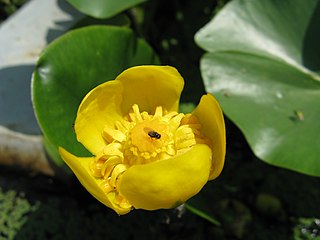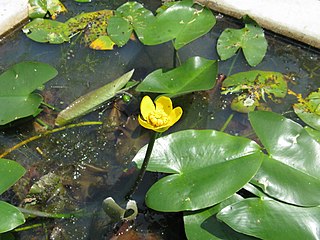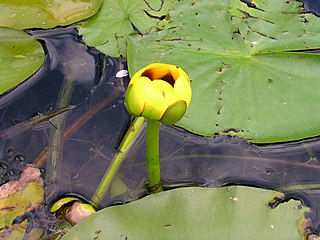
Victoria or giant waterlily is a genus of aquatic herbs in the plant family Nymphaeaceae. Its leaves have a remarkable size: Victoria boliviana produces leaves up to 3.2 metres (10 ft) in width. The genus name was given in honour of Queen Victoria of the United Kingdom.

Nuphar is a genus of aquatic plants in the family Nymphaeaceae, with a temperate to subarctic Northern Hemisphere distribution. Common names include water-lily, pond-lily, alligator-bonnet or bonnet lily, and spatterdock.

Nuphar lutea, the yellow water-lily, brandy-bottle, or spadderdock, is an aquatic plant of the family Nymphaeaceae, native to northern temperate and some subtropical regions of Europe, northwest Africa, and western Asia. This species was used as a food source and in medicinal practices from prehistoric times with potential research and medical applications going forward.

Nuphar advena is a species of Nuphar native throughout the eastern United States and in some parts of Canada, such as Nova Scotia, as well as Mexico and Cuba. It is locally naturalized in Britain.

Nymphaea mexicana is a species of aquatic plant that is native to the Southern United States and Mexico as far south as Michoacán. Common names include yellow water lily, Mexican water lily and banana water lily.

Nuphar variegata is rhizomatous, perennial, aquatic herb in the water lily family Nymphaeaceae native to much of Canada and the northernmost of the United States.

Nuphar pumila, the least water-lily, is a perennial, rhizomatous, aquatic herb in the family Nymphaeaceae native to subarctic and temperate Eurasia.

Nuphar polysepala, also known as the great yellow pond-lily, wokas, or wocus, is a perennial, rhizomatous, aquatic herb in the genus Nuphar native to western North America. It is commonly found in shallow muddy ponds from northern Alaska and Yukon southward to central California and northern New Mexico, and can be recognized easily by its large floating leaves and bright yellow blossoms.

Nuphar japonica, known as East Asian yellow water-lily, is a perennial, aquatic, rhizomatous, herb in the family Nymphaeaceae native to Japan, Korea, and Russia.

Nuphar microphylla is a perennial, rhizomatous, aquatic herb found in North America. It is listed as a special concern and believed extirpated in Connecticut.
Nuphar ulvacea is a species of rhizomatous aquatic plant native to the US-American states Alabama and Florida.

Nuphar submersa is a species of rhizomatous aquatic plant endemic to Japan.
Nuphar orbiculata is a species of rhizomatous aquatic plant native to the US-American states Alabama, Florida, and Georgia.

Nuphar × porphyranthera is a species of rhizomatous aquatic plant native to Great Britain. It is a hybrid of Nuphar lutea and Nuphar advena.

Nuphar × rubrodisca is a species of rhizomatous aquatic plant native to Canada and the USA. It is a natural hybrid of Nuphar variegata and Nuphar microphylla.

Nymphaea pygmaea is a controversial species of perennial, aquatic herb in the family Nymphaeaceae native to Asia.

Nymphaea sect. Chamaenymphaea is a section within the subgenus Nymphaea subg. Nymphaea of the genus Nymphaea native to North America, Asia, and Europe.

Nuphar pumila subsp. sinensis is a subspecies of Nuphar pumila native to China.

Nuphar sect. Astylus is a section within the genus Nuphar native to North America.

Nuphar sect. Nuphar is a section within the genus Nuphar native to Eurasia, in addition to a single North American species Nuphar microphylla.

















